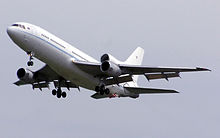Future Strategic Tanker Aircraft
Future Strategic Tanker Aircraft (FSTA) is a British project to procure aerial refuelling (AR) and air transport (AT) for the Royal Air Force to replace VC10 and Lockheed Tristars then in service. After evaluation of bids the RAF selected the Air Tanker consortium who had offeed the Airbus A330 MRTT. The Royal Australian Air Force announced in April 2004 that they had selected Airbus to provide tankers to a similar specification.
Background

Plans involve the replacement of the RAF's current fleet of Vickers VC10s from 2008 and the Lockheed Tristars around 2012. The new fleet will continue to operate from the RAF air transport hub, RAF Brize Norton, Oxfordshire. It has yet to be announced what role the current AAR/AT squadrons, No. 101 and No. 216, will have in the PFI arrangement.
The FSTA will be a Private Finance Initiative (PFI) where the RAF will pay for aerial refuelling and air transport missions as required. The RAF will continue to retain responsibility for all military missions, whilst the contractor will own, manage and maintain the aircraft and also provide training facilities and some personnel. The private company will also be able to earn extra revenue by using aircraft for commercial operations when not required by the RAF — the most suitable of which would be leased air-refuelling missions for other European air forces. The RAF however will always have the "first call" on aircraft, being able to mobilise the entire fleet in times of crisis.
Competition
Final bids for the project were received from the two competing consortia on 30 April 2003.[1]
- Air Tanker Ltd offered a mix of new and used Airbus A330-200s, team composed of:
- Rolls-Royce - Trent 700 turbofans
- Cobham - Air-refuelling hose and drogue system
- EADS - Airbus A330-200
- Thales Group - Avionics etc.
- Tanker Transport Services Consortium (TTSC) offered converted British Airways Boeing 767s:
- British Airways - Aircraft
- Boeing - Conversion technology, using the KC-767 as the basis of the design.
- BAE Systems - Conversion of majority of aircraft and mission systems.
- Marshall Aerospace
- Serco [2]
- Spectrum Capital
Aircraft selection
The UK Ministry of Defence announced on 26 January 2004 that Air Tanker had been selected to enter into final negotiations to provide the RAF's FSTA.
The reasons for the selection of Air Tanker are many and varied but include:[citation needed]
- An overall more capable aircraft in the Airbus A330
- The Airbus A330-200 cost more but can carry more fuel than early model KC-767.(The KC-30 is another name for the A330 MRTT) "Northrop spokesman Randy Belote said Northrop's K-30 would tack on roughly 20 percent in fuel capacity."[3]
- fuel offload of 111 tonnes is achieved without the need for additional fuel tanks — leaving aircraft cabin free for passenger and air cargo operations
- The attraction of a European solution over a British solution (such as BAE Systems) with associated employment in France and Germany, although the wings are made by Airbus UK.
- Aircraft conversion to tanker configuration
- Fitment of military avionics
- Aircraft certification
- Tension between Ministry of Defence and BAE Systems over project delays and cost rises on other major projects[citation needed] (e.g. Nimrod MR4 and Astute class submarines)
Contract negotiations
Following aircraft selection the UK MoD began exclusive negotiations with the Airtanker consortium. However, beginning in April 2004, there were rumours about the fragile state of the contract negotiations. This culminated in an ultimatum by the UK Defence Procurement Agency, delivered to EADS, demanding a reduced price for the aircraft. With continuing doubts over the FSTA programme, Marshall Aerospace, responsible for the conversion of the RAF's original Tristars, have offered to buy and convert some of the large number of surplus commercial Tristars.[citation needed]
On 28 February 2005 the MoD named Airtanker as its preferred bidder for the £13bn contract. Air Forces Monthly reports that the tanker shortage that could result from any further serious delay has led some RAF personnel to joke that FSTA stands for "F*cking Short of Tankers Again".
AirTanker awarded contract
The MoD announced on 6 June 2007 that AirTanker had been given the approval it needed to continue with the project, allowing the company to seek the £2 billion private financing required to begin funding the aircraft.
On 27 March 2008, the UK signed a contract with AirTanker for £13 billion over the course of the contract, and will involve 14 converted A330 aircraft being delivered from 2011 onward.[4] This is two years later than in previous discussions.
The first airframe was delivered for tanker conversion in July 2009.[citation needed]
The first of 14 Airbus Military A330-200 multi-role tanker transport aircraft for the UK's future Strategic Tanker Aircraft (FSTA) programme made its maiden flight from the company's facilities in Toulouse on June 4, 2009.
See also
Notes and References
- ^ Future Strategic Tanker Aircraft (FSTA) fact sheet, UK Ministry of Defence.
- ^ the facilities management company already operating Brize Norton
- ^ Northrop has been viewed as the underdog, with a heavier, less fuel efficient aircraft. The Airbus tanker would have a maximum fuel capacity of 200,000 pounds. Northrop spokesman Randy Belote said Northrop's K-30 would tack on roughly 20 percent in fuel capacity. http://seattletimes.nwsource.com/html/boeingaerospace/2003569219_tanker13.html
- ^ Hoyle, Craig. "UK signs £13 billion tanker deal", Flightglobal.com, 27 March 2008.
